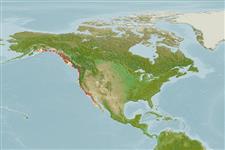Bivalvia |
Venerida |
Mactridae
Environment: milieu / climate zone / ระดับความลึก / distribution range
นิเวศวิทยา
; ระดับความลึก 0 - 50 m (อ้างอิง 95344). Temperate; 61°N - 22°N, 156°W - 109°W
Eastern Pacific: from Alaska to Baja California, Mexico.
Length at first maturity / ขนาด / Weight / Age
วัยเจริญพันธุ์: Lm 6.8 range ? - ? cm Max length : 25.4 cm SHL เพศผู้/กระเทย; (อ้างอิง 95991); อายุสูงสุดที่ได้รายงาน: 17 ปี (อ้างอิง 95991)
It burrows in sand and mud along the intertidal zone from shallow depths to 30 meters (Ref. 865). Prefers sandier areas. Buries deep in the substrate to avoid freezing (Ref. 95344). Feeds on phytoplankton and detritus (Ref. 95991).
Life cycle and mating behavior
วัยเจริญพันธุ์ | การสืบพันธุ์ | การวางไข่ | Eggs | ความดกของไข่ | Larvae
Reproduction occurs throughout the year during spring, peak months on February and April.
Lamb, A., D. Gibbs and C. Gibbs 2011 Strait of Georgia biodiversity in relation to bull kelp abundance. Pacific Fisheries Resource Conservation Council, 111p. (อ้างอิง 93817)
IUCN Red List Status
(อ้างอิง 130435: Version 2025-1)
CITES status (อ้างอิง 108899)
Not Evaluated
CMS (อ้างอิง 116361)
Not Evaluated
Threat to humans
Human uses
การประมง: การค้า
FAO - การเพาะเลี้ยงสัตว์น้ำ: production; | FishSource | ทะเลรอบๆเรา
เครื่องมือ
ข้อมูลเพิ่มเติม
Human RelatedStamps, coins, misc.
แหล่งที่มาจากอินเตอร์เน็ต
Estimates based on models
Preferred temperature
(Ref.
115969): 8.6 - 15.3, mean 10.2 (based on 60 cells).
ความสามารถในการกลับคืนสู่ปกติ
ต่ำ, เวลาต่ำสุดที่จะทำให้ประชากรเพิ่มขึ้นเป็น 2 เท่าใช้เวลา 4.5 - 14 ปี (K=0.12-0.17; tm=3; tmax=17).
Fishing Vulnerability
Moderate vulnerability (45 of 100).
Nutrients : Calcium = 149 [71, 228] mg/100g; Iron = 8.53 [1.95, 15.11] mg/100g; Protein = 9.88 [8.64, 11.12] %; Omega3 = 0.313 [0.202, 0.423] g/100g; Selenium = 61 [50, 72] μg/100g; VitaminA = 0 μg/100g; Zinc = 2.04 [0.56, 3.51] mg/100g (wet weight); based on
nutrient studies.
